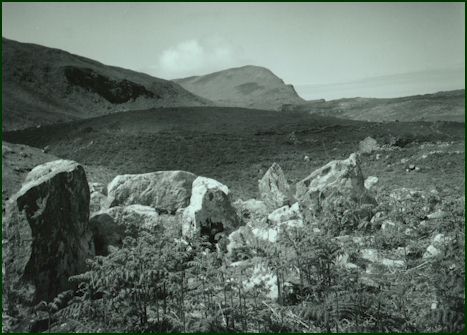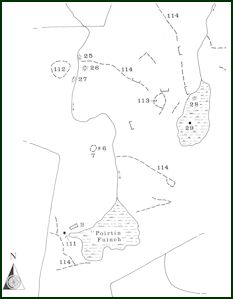| 1. Symposia / Historical Safaris
3. Research 4. Surveys
7. Folklore 9. Contact us 11. Links |
1. Megalithic
Tomb
This existence of this tomb was confirmed by the archaeologist, Paul Gosling in August 1989, having been first identified by Dr Peter Gill, of the Centre for Island Studies, Clare Island, as a possibly ancient structure some time before. It was surveyed by Paul Walsh, Megalithic Survey of Ireland, Ordnance Survey Office, Phoenix Park, Dublin in 1993 (Figure 18). With its discovery, we can now discern a definite Neolithic horizon of activity on Clare Island, probably dating back to the mid-third millennium before Christ (c. 3800-3,000 BC). The monument occupies a saddle between two hillocks amidst the stark hummocky moraine topography to the E of Glan Hill (Knocknaveen on OS map). While thus sheltered from the prevailing winds, the site offers wide views to the north and east over the Lough Avullin basin and the north-eastern part of the island.. Immediately to the E of the tomb is a small peat basin known locally as"Poirtin Fuinch". The tomb itself is a jumble of large stones, mantled, in the summer months, by a dense growth of bracken . An examination of the structural stones reveals that the tomb is of the court-tomb type, comprising one long and slightly wedge-shaped chamber (L 5.6m, Wth 2m max.) aligned ENE-WSW. Outside it, at the eastern end there was once a court, only four set slabs of which survive amid the mass of loose stone. From the extent of the latter, it would appear that the tomb was contained within a large cairn which now survives as a low oval cairn c. 19.25m long by c. 12.3m in maximum width. Though none of the original capstones survive a number of the massive corbel slabs are still in evidence along the SSE side of the chamber. Court-tombs are one of four main types of megalithic tombs known in Ireland. Over 300 of these tombs are now known, and their distribution is generally confined northern part of Ireland. Along with the less numerous portal tombs their presence is thought to represent an early horizon of Neolithic settlement. From excavated examples, we know that the burial rite in these tombs frequently took the form of what is known as collective burial. This often involved the burial of the cremated remains of a number of individuals. Collective deposits of disarticulated unburnt bones also occur occasionally, suggesting the dead were left 'exposed for some time before burial. The human remains were accompanied by fragmentary remains of pottery vessels, simple ornaments, and stone implements. Apart from their role as burial monuments, megalithic tombs are also likely to have acted as focal points for the communities who built them, possibly fulfilling roles as places of assembly for law-making, games, and rituals connected with the cycle of the seasons.
Map showing part of Fulachta Fiadha group and other settlement at Lecarrow, Clare Island
|


